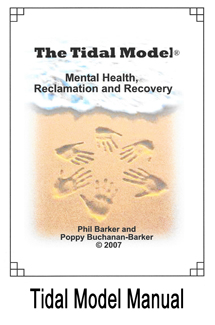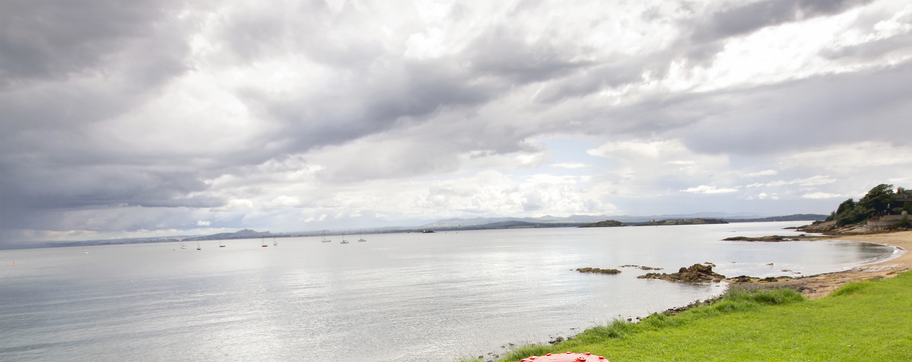The Purpose of Practice
The Tidal Model is, fundamentally, existential in character. Our interest is in the person's experience of her or himself. This focus becomes the basis for all the decisions made regarding what 'needs to be done' to address the person's particular problems in living.
In keeping with this philosophical outlook we assume that the person is free to choose, and is ultimately responsible for their actions.
The role of the professional helper is to support the person in making decisions about what 'needs to be done' and then in carrying these out in everyday life.
The Tidal Focus
Our motto is borrowed from the work of Shoma Morita: "First, know your purpose...then...do what needs to be done".
Our purpose is simple - although its attainment may be difficult. It is to help the person to return to everyday life as soon as possible.
Having established our purpose we must support the person in identifying 'what needs to be done' to realise this.
![]() In the Tidal Model
the first steps in recovery are taken as soon as the person enters
the care setting. No time should be wasted. The aim is to
help establish the conditions needed to return the person to
everyday life as soon as possible.
In the Tidal Model
the first steps in recovery are taken as soon as the person enters
the care setting. No time should be wasted. The aim is to
help establish the conditions needed to return the person to
everyday life as soon as possible.
![]() All aspects of the practice of
Tidal serve as a rehearsal for everyday living. At
every stage of practice the helper tries to strengthen the person's
autonomy - encouraging the person to take 'the driving seat'.
All aspects of the practice of
Tidal serve as a rehearsal for everyday living. At
every stage of practice the helper tries to strengthen the person's
autonomy - encouraging the person to take 'the driving seat'.
![]() The practice of the
Tidal Model is based on four key questions.
The practice of the
Tidal Model is based on four key questions.
1. How might the person be helped
to feel safe and secure and what needs to be done for this to be
realised?
The Personal Security Plan is
designed to address this issue.
2. Who is the person and what are
their problems of living?
The Holistic Assessment
is designed to address this issue.
3. How might we help the person
begin to develop their own way of living, constructively, with their
problems?
The One to One Sessions are designed
to address this issue.
4. What might the person learn
about themselves and their problems through discussion with others?
The three Tidal Groups are designed to address this issue.
Do What Needs to Be Done
The practice of the Tidal
Model is pragmatic. It emphasises working directly with the
personãs problems in living; doing whatever appears to be
appropriate; doing what works for the person ã¢ceasing to do
anything that seems not to work.
Tidal practice is created afresh
each time the helper and the person meet. At these meetings they
work out what ã¢em>needs to be doneã¢and then decide how this
might be enacted each and every day.
The Key Tidal Processes
There are four key processes in the Tidal Model. These are used to learn more about the person and to work out ãwhat needs to be doneã¢to address their problems in living.
1. The Personal Security
Plan
Care settings are expected to ensure that the
person is kept ãsafeã¢- not exposed to any obvious hazards or any
other risk of coming to harm. However, although a person might be
safe in a physical sense, they might still feel very insecure.
Unlike physical problems ã¢e.g. a broken limb or high fever ã¢
problems in living exhibit no ãsigns㢠Instead, all such problems
are abstract: they are experienced only within the person ã¢
in the form of specific thoughts and feelings. If we are to help the
person to be both safe and secure we need to establish what needs to
be done to help increase that sense of personal and private
ãsecurityã¢
The Personal Security Plan
was developed with the support of people with experience of
distressing or disabling problems of living: those who had attempted
suicide, self-harmed or felt threatened by ãvoicesã¢or ãthoughtsã¢
The aim is to help the person
identify what they can do for themselves and what others might do
for or with the person that might increase the sense of personal
security.
This is the most common starting
point for Tidal. If people do not feel emotionally
secure, they are unlikely to be willing to explore the nature and
meaning of their problems in living.
2. The Holistic
Assessment
In traditional health and social care a
ãpatientã¢or ãclientã¢is ãadmittedã¢to the care setting. Usually
this ãadmissionã¢is arranged through referral from a psychiatrist or
another health or social care professional. The ãhistoryã¢that
accompanies the admission focuses on the ãpatient/clientãsã¢illness
or disorder, medical history and family history.
However useful the history might be
it represents only a professional account of the situation. This is
similar to a description of a shipwreck by bystanders on the beach.
In the Tidal Model we are interested in a
personal account. We want to hear the story from the person who
'survived the shipwreck'.
What, exactly, happened to the
person? How did this affect them? How have they coped with this? Who
helped them? In what way?What do they think, feel and believe about
this event in their life?
We want to develop a more complete picture of the person ã¢framed in their words, rather than ours.
The Holistic Assessment
was developed with the support of a wide range of people
with personal experience of psychiatric care, sometimes with
repeated ãadmissionsã¢over many years. This large group helped us
appreciate what was missing from traditional psychiatric or
psychotherapeutic ãassessment㢠They also helped us refine the
wording and format of the Holistic Assessment,
making it ãuser-friendlyã¢
3.The One-To-One Session
The Holistic Assessment identifies the problems
which brought the person into care. In the One to One
Sessions the person is helped to begin to address these
problems.
However, time does not stand still.
What was a major problem yesterday may have been displaced by a
ãnewã¢problem. Instead of using a ãfixedã¢problem list each
One to One Session begins by asking the person what they
wish to talk about. What is troubling them now?
It is only respectful to allow the
person a little time to talk about the ãproblem㢠how it begun or
affected the person etc. However, the real starting point of the
session involves asking the person how they would like things to
be. What would they want to be different? This will
represent the person's ultimate ãaimã¢ã¢however distant.
The rest of the session focuses on
discussing, in practical detail, how the person might begin
to move towards this aim.
- What does the person do at
present
that is helpful or constructive?
- How might they do more
of this?
- What else might they do?
- What help
might they get from others to deal with the problem and
begin to move towards the aim?
These sessions focus on helping the
person take charge of their situation; begin to think about
what ã¢em>needs to be done㢠develop a structured plan
for doing this in everyday life. This is the beginnings of what
might be called ã¢em>self-managementã¢
In the Tidal Model our
aim is to help the person understand better the resources they
already possess, what they have learned afresh about themselves
over the time in care, so that they will have something to draw upon
when confronted by new problems in living ã¢or perhaps a return of
the old ones.
The Records of Practice
All
the written records of conversations within the Personal
Security Plan, Holistic Assessment and
One to One Sessions are made ãin situã¢/em> ã¢
along with the person. Wherever appropriate, the person will be
encouraged to make the record in their own hand. If this is
not possible, the professional will act as ãsecretary㢠recording
only what the person wishes recorded, exactly as
they wish it recorded. The person is always provided with copies
of each sessionãs recordings for their own reference, which they may
share with family/friends or keep private.
.
At the end of each session the
helper will make a copy for the person and place the
original in the personãs records.
This is only appropriate. The
story that is documented, drawn upon, or further developed in these
records belongs to the person. It would be inappropriate to make a
professional record ã¢which will be filed and maintained for years ã¢
without providing a copy of this for the personãs reference.
These records not only help to
remind the person what has been discussed but serves as a ãmemory
aid㢠reminding the person what ãneeds to be doneã¢in specific
situations in everyday life.
4. Group Work
Group work is a very important part of the Tidal Model.
All people learn about life and themselves through group experience.
Reading books, schooling and other forms of formal education help
the individual acquire knowledge or information. However, we learn
about human relations ã¢and life itself ã¢in the family home, the
school playground and through membership of formal and informal
social groups across the lifespan.
Most care settings offer some kind
of group activity. This is either a formal ãtherapyã¢group or serves
as a distraction from the personãs everyday worries. The three
groups within the Tidal Model are designed to serve
as rehearsals for the kind of group activity found in
everyday life. In many settings the team may introduce the person to
one of the groups as a first step into the Tidal Model.
The group may serve as an important ãwarm upã¢for the individual
work, helping the person become more comfortable in talking about
themselves and their personal experience.
The Discovery Group
focuses on helping the person meet and share with others their
experience of things that matter, are meaningful or significant..
Originally named the ãrecovery groupã¢this group was re-named by
people in a high security unit in New Zealand . They said that after
a very long time in care they had ã¢em>finally learned important
things about one another and about themselves㢠In this group
two staff members also participate. By sharing details from their
personal lives they act as important role models for the people in
care.
The Information Sharing
Group focuses on providing information on any personal,
health or social issue that might concern individual members.
-
People may be confused about the different treatments on offer; may
have problems with money, housing or family; or need legal advice.
They may need information either to help make a decision or simply
to be better-informed.
Given Tidal's
person-centred nature all topics are chosen by group members
themselves. Someone with expert knowledge of a particular topic is
invited in to answer the groupãs questions. This format puts all the
group members ãin the driving seatã¢
The Solutions Group
focuses on group discussion of specific problems in living. What is
the individual membersã¢experience of such problems? How have they
been affected by this problem? How do they cope with, manage or
otherwise live with this particular difficulty or issue?
The group is facilitated by a staff
member but offers no advice or direction. Instead, the group members
are encouraged to share experiences, learn from one another and,
perhaps, begin to see problems from a slightly different
perspective.
The Tidal Model Manual
 You can learn more about the practice of
the Tidal Model by reading our 120 page manual.
You can learn more about the practice of
the Tidal Model by reading our 120 page manual.
This describes, in detail, the use of the
four processes, along with examples. You can order a FREE COPY here.
To order your copy click here (Order
the
Tidal Manual)






